
Dulwich Hill is a suburb in the Inner West of Sydney, in the state of New South Wales, Australia. It is 7.5 kilometres south-west of the Sydney central business district, in the local government area of Inner West Council. Dulwich Hill stretches south to the shore of the Cooks River.

Metro Transport Sydney (MTS) was the owner of the now-demolished Sydney Monorail and the former owner of the Inner West Light Rail in Sydney, New South Wales. Established in 2001, it replaced the Sydney Light Rail Company (SLRC), the previous owner of the light rail, and CGEA Transport Sydney, the previous owner of the monorail. It was bought by the New South Wales Government in 2012. The Metro Transport Sydney brand was discontinued from 1 July 2013, and the SLRC and Metro Transport Sydney were deregistered later that month.

Transport in Sydney is provided by an extensive network of public transport operating modes including metro, train, bus, ferry and light rail, as well as an expansive network of roadways, cycleways and airports. According to the 2006 census, in terms of travel to work or study Sydney has the highest rate of public transport usage among the Australian capital cities of 26.3% with more than 80% of weekday trips to/from Central Sydney being made by public transport. According to the New South Wales State Plan, the state has Australia's largest public transport system. The public transport network is regulated by Transport for NSW.

The Sydney Freight Network is a network of dedicated railway lines for freight in Sydney, Australia, linking the state's rural and interstate rail network with the city's main yard at Enfield and Port Botany. Its primary components are the Southern Sydney Freight Line (SSFL) and a line from Sefton to Enfield and Port Botany. The Network has been managed by the Australian Rail Track Corporation (ARTC) since 2012. Prior to the completion of the SSFL, it was managed by RailCorp as the Metropolitan Freight Network.

Circular Quay ferry wharf is a complex of wharves at Circular Quay, on Sydney Cove, that serves as the hub for the Sydney Harbour ferry network.

Buses account for close to six per cent of trips each day in the city of Sydney, New South Wales, Australia, forming a key part of the city's public transport system. The network initially evolved from a privately operated system of feeder services to railway stations in the outer suburbs, and a publicly operated network of bus services introduced to replace trams in the inner suburbs. The bus network has undergone major reforms since the 2000s–2010s, with the New South Wales Government taking responsibility for route and fare-setting, opening contracts for most routes up to competitive tendering, and introducing more cross-suburban services.

Sydney, the largest city in Australia, has an extensive network of passenger and goods railways. The passenger system includes an extensive suburban railway network, operated by Sydney Trains, a metro system and a light rail network. A dedicated goods network also exists.

The earliest trams in Australia operated in the latter decades of the 19th century, hauled by horses or "steam tram motors". At the turn of the 20th century, propulsion almost universally turned to electrification, although cable trams lingered in Melbourne. In cities and towns that had trams, they were a major part of public transport assets.

Metrobus is a high frequency, high capacity bus network in Sydney, Australia, first introduced in 2008. Metrobus services run every 10 minutes during peak periods, 15 minutes during off-peak weekday periods, and 20 minutes on weekends, linking key commercial suburbs and centres throughout the city, with the intention of making timetables obsolete. All buses were initially painted in a distinctive red livery but recently, the standard Transport for NSW livery of blue and white has been adopted. All Metrobus services are wheelchair accessible. All route numbers were prefixed with an "M" followed by a two-digit number.
Various railway lines have been proposed for Sydney, Australia, including both heavy rail extensions to the dominant suburban network, and more recently proposals for metro lines – one of which was completed in 2019. There have been various proposed light rail expansions, which are covered separately.
The CAF Urbos is a family of trams, streetcars, and light rail vehicles built by CAF. The Spanish manufacturer CAF previously made locomotives, passenger cars, regional, and underground trains. In 1993, CAF started building trams for Metrovalencia, with the delivery of 16 trams until 1999. This was a variant of a Siemens design and some components were delivered by Siemens, including bogies and traction motors. This design was also sold to Lisbon Trams in 1995; CAF then decided to design and build the Urbos in-house.

Sydney Trains is the operator and brand name of the principal train network serving the Greater Sydney metropolitan area in New South Wales, Australia. The network is a hybrid urban-suburban rail system with a central underground core that covers 369 km (229 mi) of route length over 813 km (505 mi) of track, with 170 stations on eight lines.

The Inner West Light Rail is a 12.8-kilometre (8.0 mi) light rail line in Sydney, New South Wales, Australia, running from Central railway station through the Inner West to Dulwich Hill and serving 23 stops. It was the original line of the Sydney light rail network. Services on the line are branded as the L1 Dulwich Hill Line since 2014.

The Sydney Metro is a fully automated rapid transit rail system in Sydney, New South Wales, Australia. It currently consists of the Metro North West & Bankstown Line, running between Tallawong and Sydenham and consisting of 21 stations on 52 km (32 mi) of twin tracks, mostly underground. The first stage of the line opened on 26 May 2019, running between Tallawong and Chatswood. This line was extended from Chatswood to Sydenham on 19 August 2024 as part of the first stage of the City & Southwest project. The second stage of the project will then further extend this line to Bankstown as part of a partial conversion of the existing Bankstown Line with a scheduled completion in 2025.

The CBD and South East Light Rail is a pair of light rail lines running between Sydney's central business district (CBD) and the south-eastern suburbs of Sydney, New South Wales, Australia. Services running between Circular Quay and Randwick are branded as the L2 Randwick Line, with services running between Circular Quay and Kingsford branded as the L3 Kingsford Line. Construction commenced in October 2015, with the L2 Randwick Line commencing services on the 14 December 2019 and the L3 Kingsford Line on the 3 April 2020. It is part of Sydney's light rail network.
Transdev Australasia is an operator of bus, ferry, light rail and heavy rail services in Australia and New Zealand. It is a subsidiary of French-based, international Transdev. It was formed in 2013 by grouping the operations of Veolia Transport Australia and former Transdev together, as a result of the global rebranding from Veolia Transdev to Transdev.

The Inner West & Leppington Line is a commuter rail service currently operated by Sydney Trains, serving the inner west and south-western regions of Sydney, Australia. Consisting of 37 stops, the service commences from the City Circle, then heads west to Granville. The line branches at this point; services either head northwest to Parramatta or south to Leppington. A third terminus at Homebush is used when the part-time Parramatta branch isn't operating. The line commenced operations on 26 November 2017, replacing the T2 Airport, Inner West & South Line.

The Newcastle Light Rail is a light rail system in Newcastle, New South Wales, Australia, running from Newcastle Interchange through the central business district to Pacific Park. Major construction commenced in September 2017 and the line was opened on 17 February 2019. It is operated by Newcastle Transport for Transport for NSW.

The Parramatta Light Rail is a 12-kilometre (7 mi) standard gauge light rail line currently under construction in Sydney, New South Wales, Australia.
The 2010s saw many developments relating to transport in the Australian city of Sydney. The decade saw a substantial investment in infrastructure, including a new airport, motorway projects, light rail lines, Australia's first metro system, the new Waratah fleet and the demise of the non-air conditioned S sets from the rail network. Planning and branding of public transport services became substantially more centralised.





































